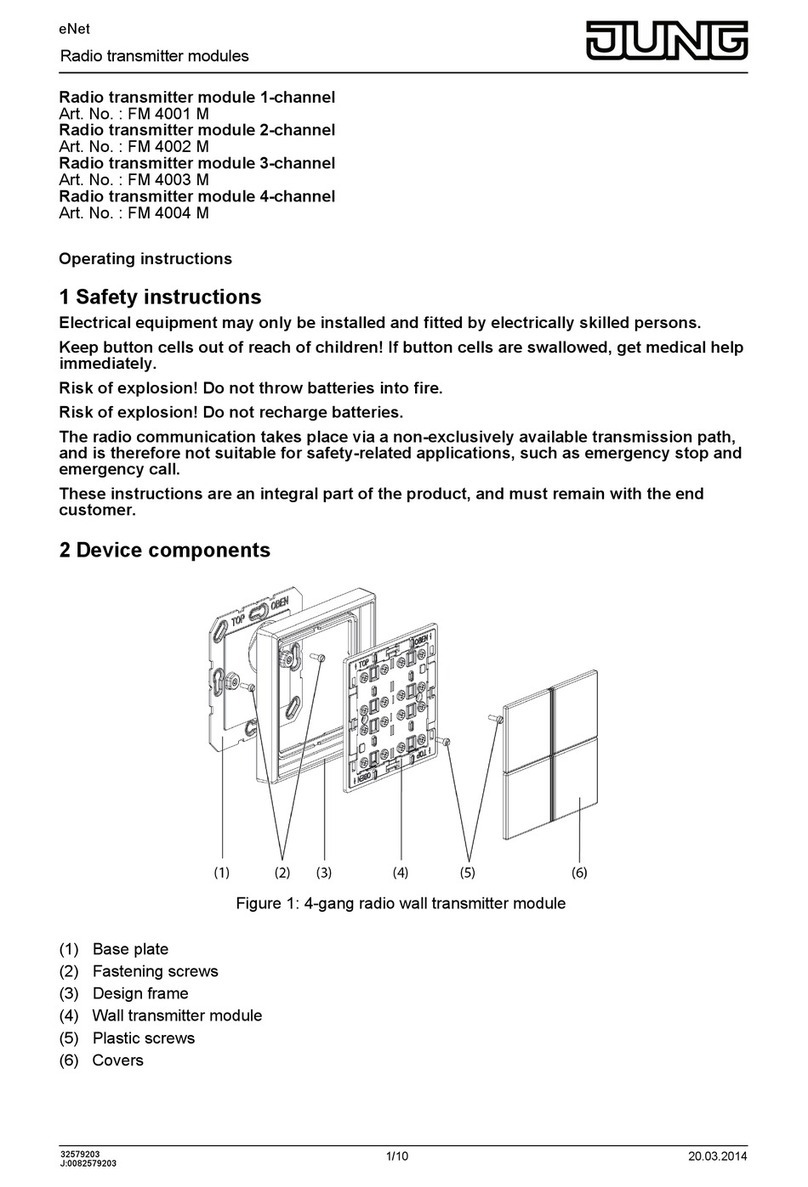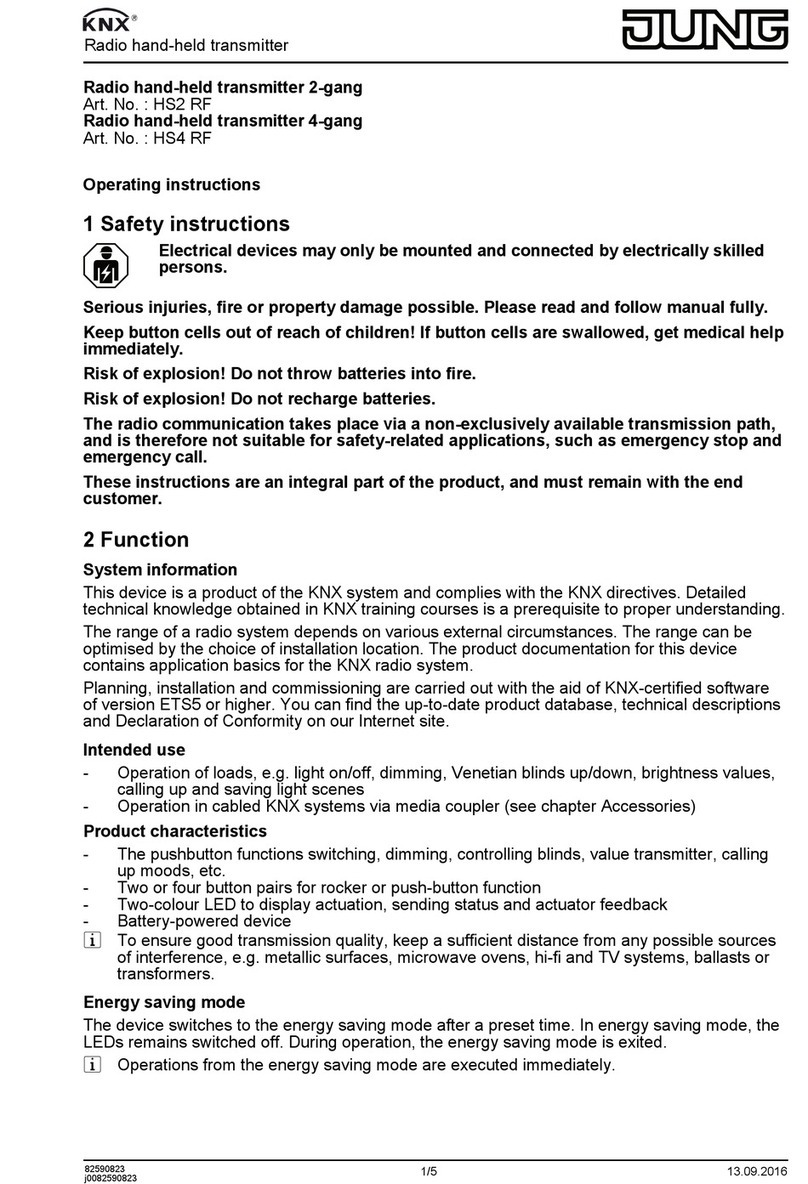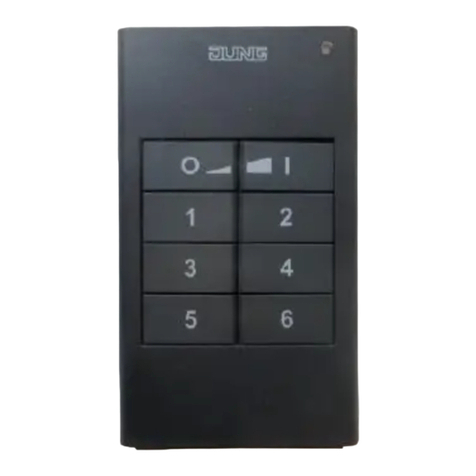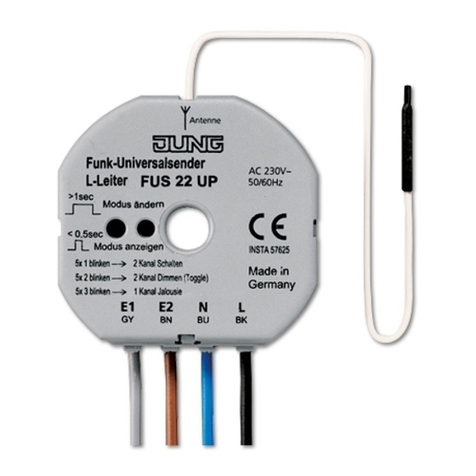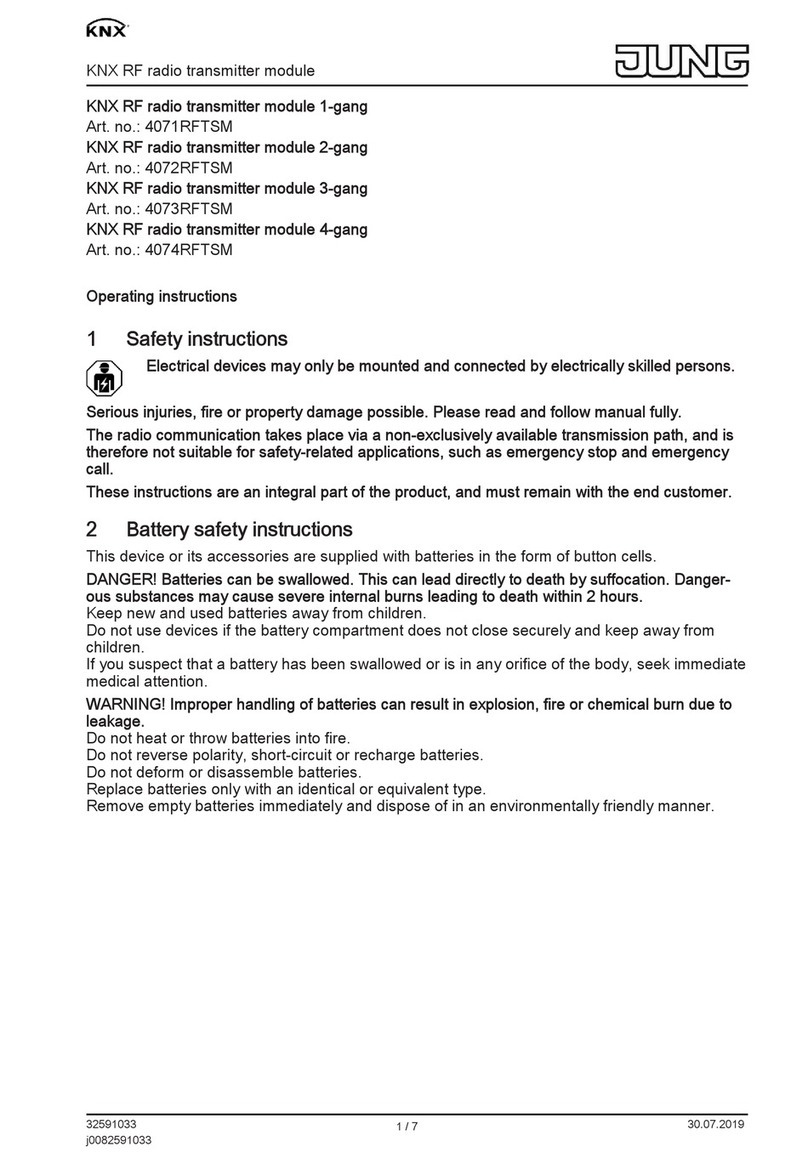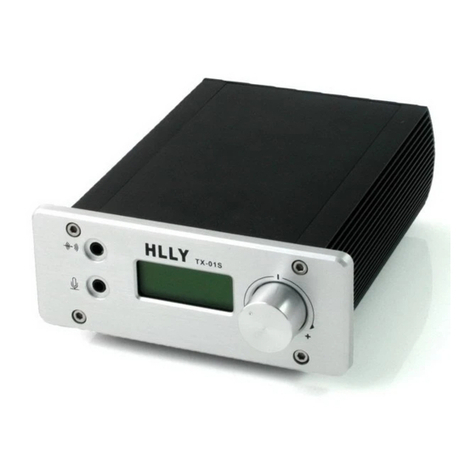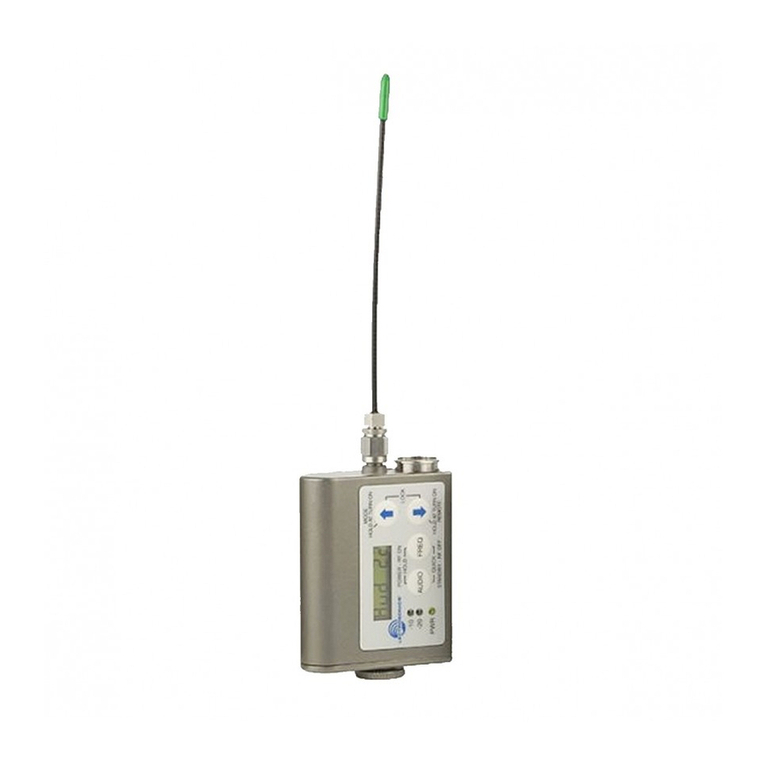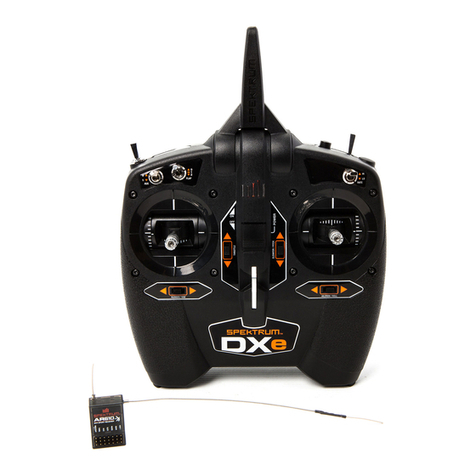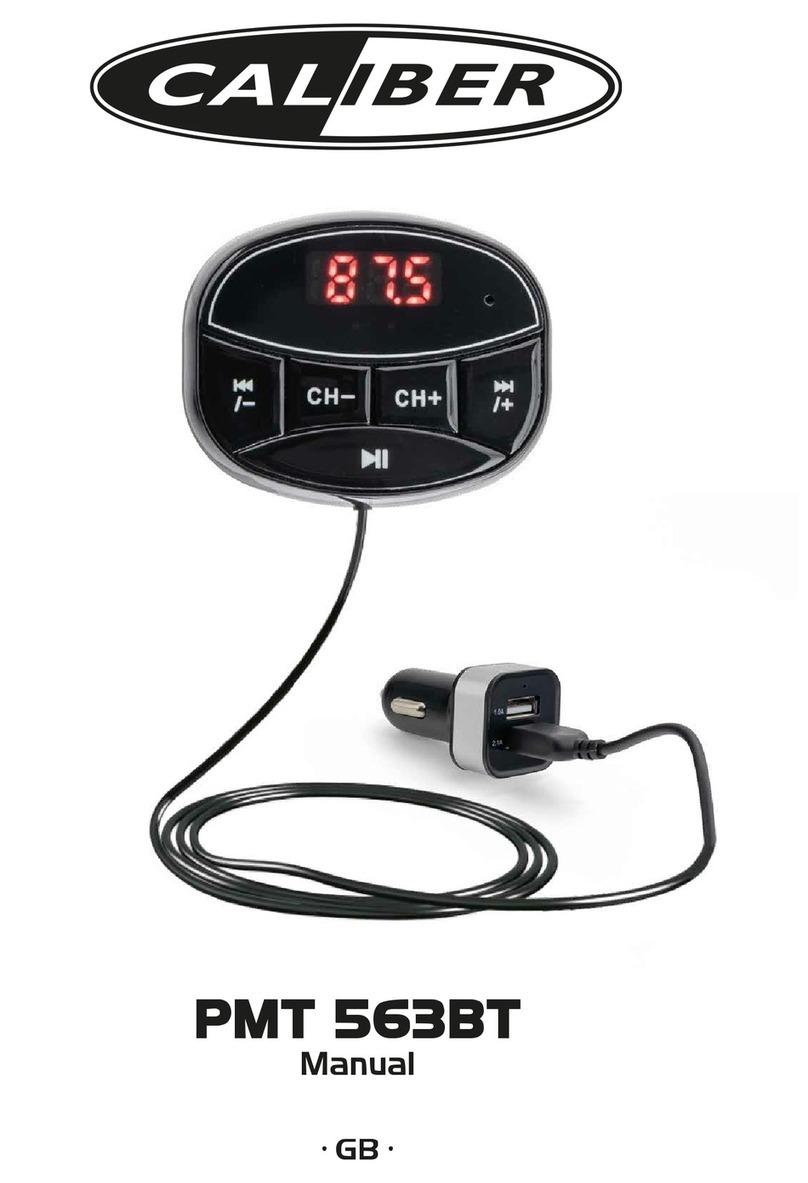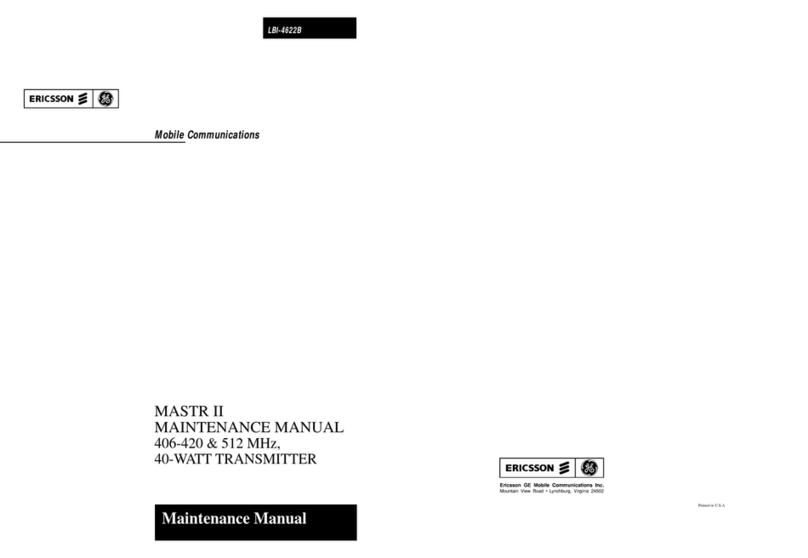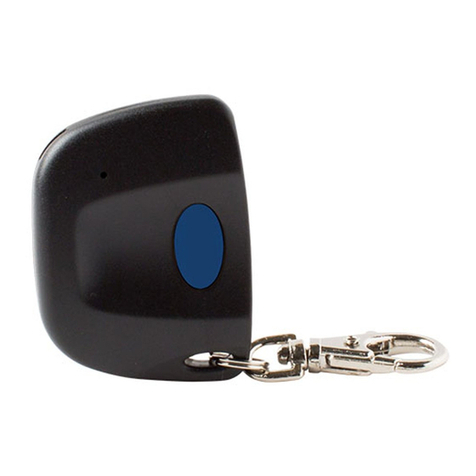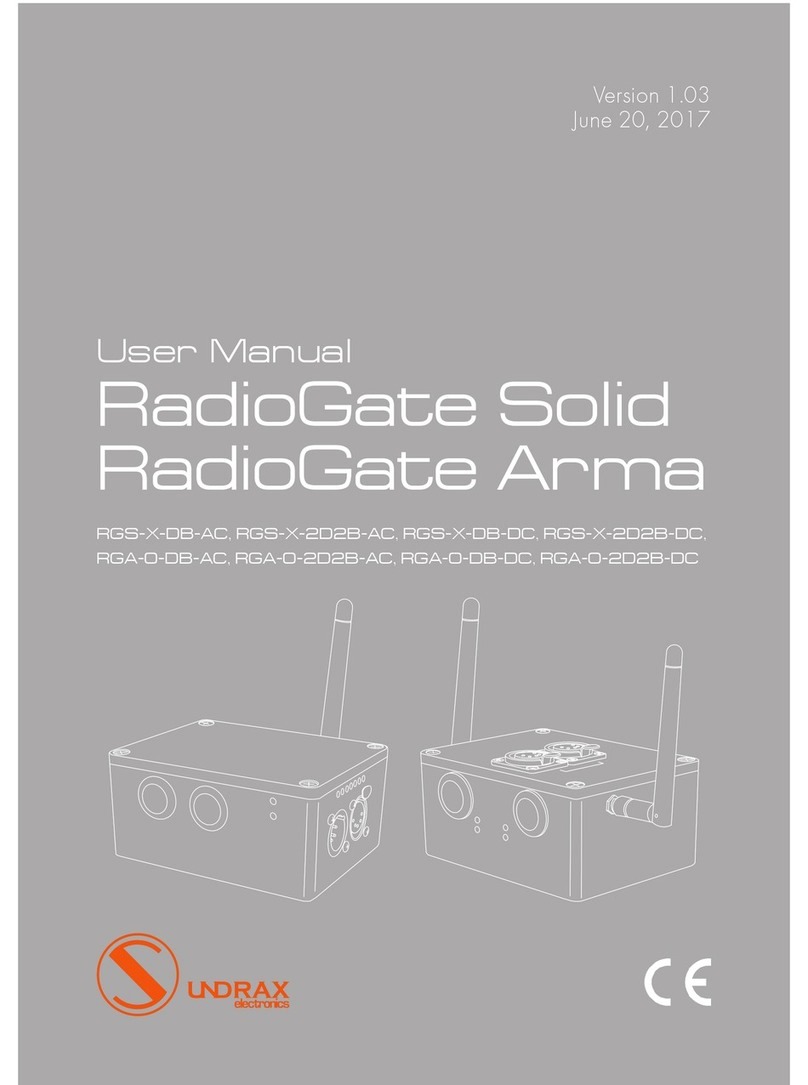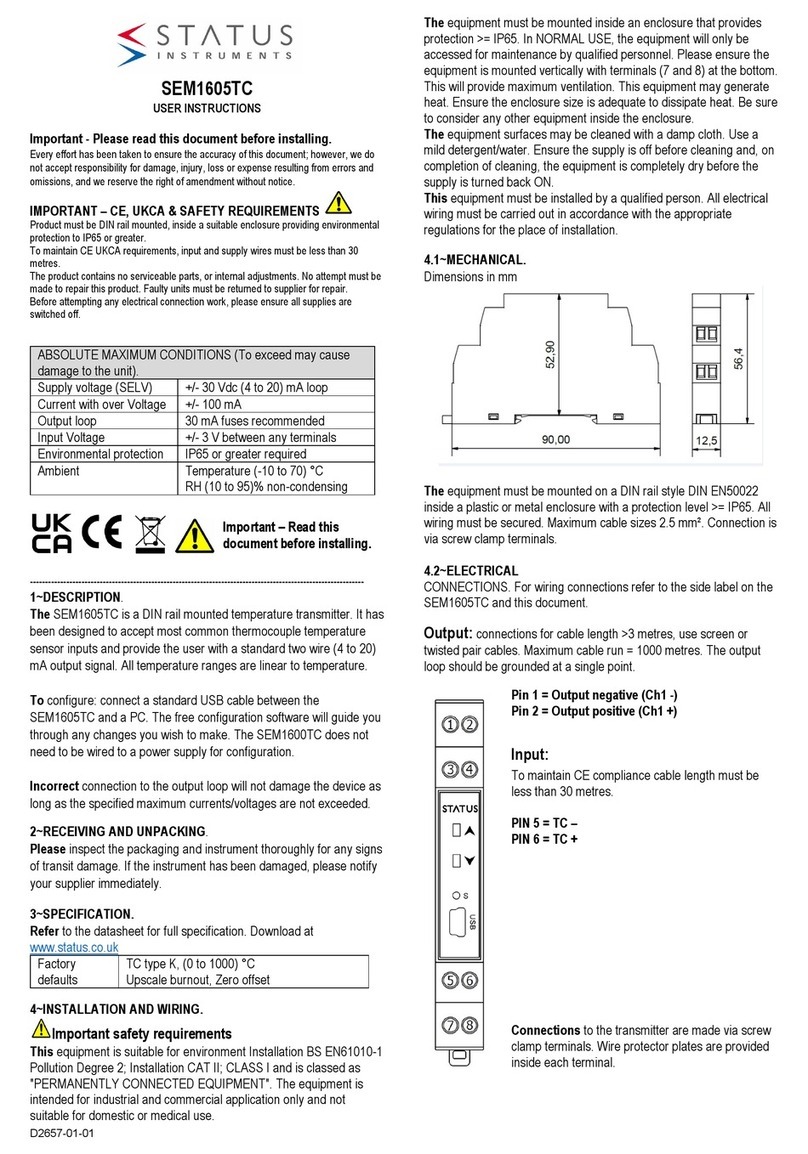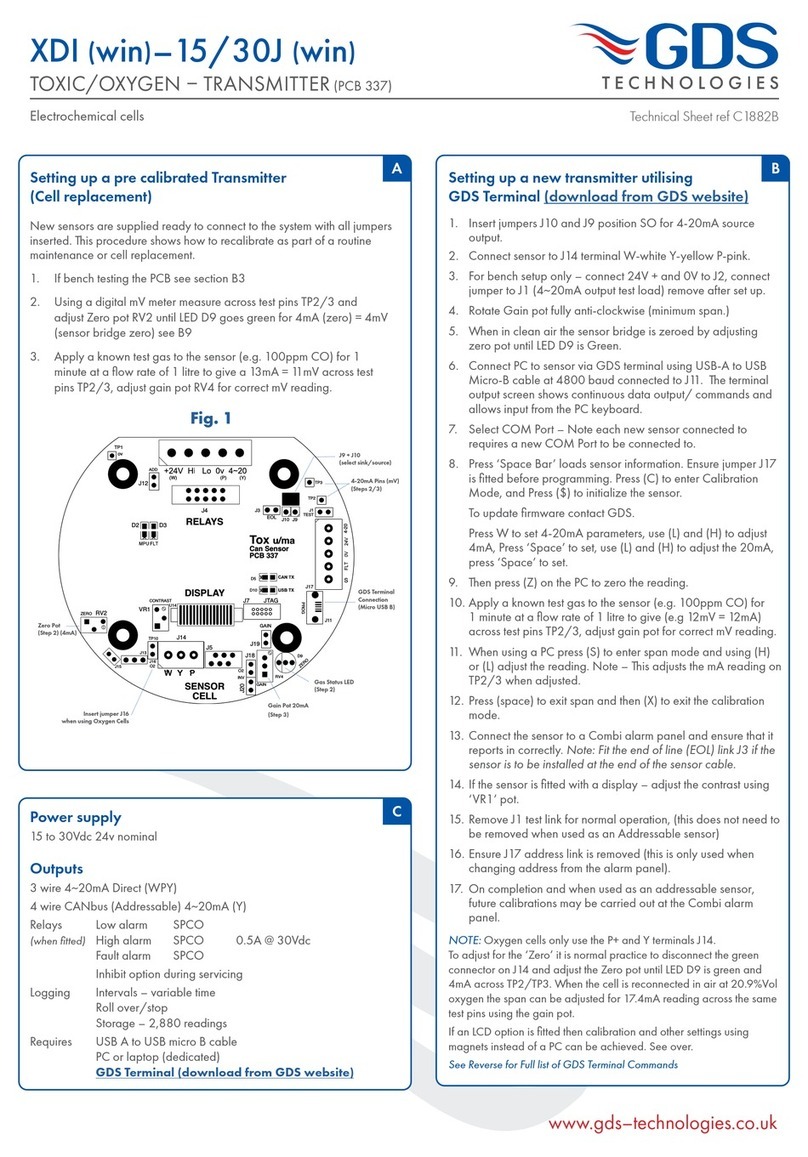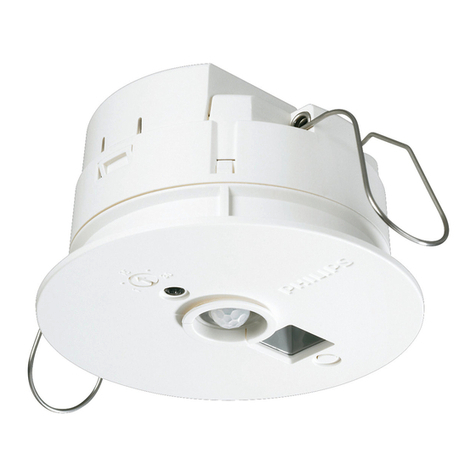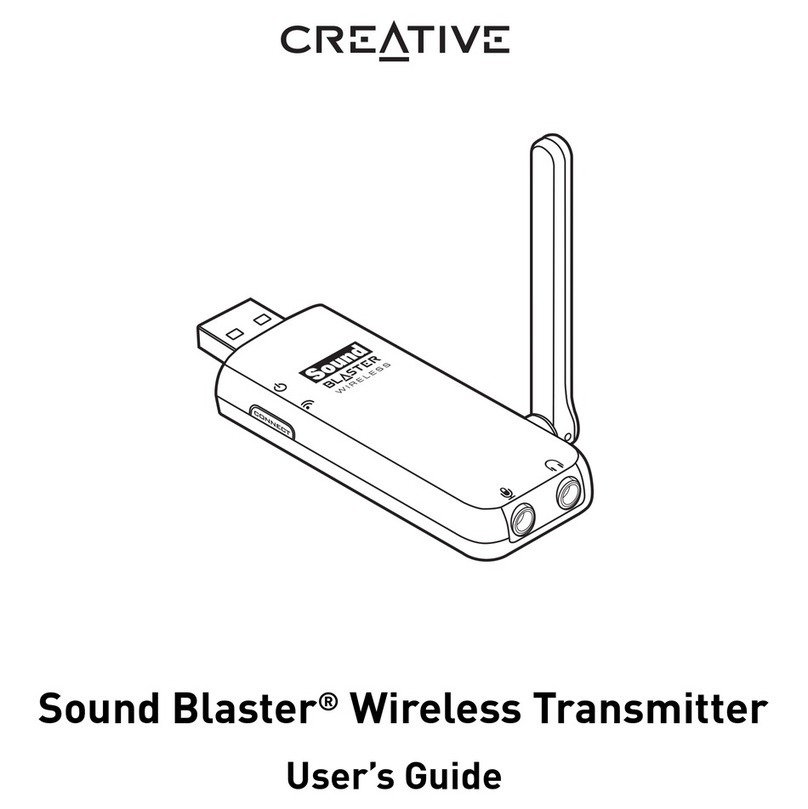Jung A 41 F Series User manual

Flat wall-mounted radio transmitter
Radio Management
Flat wall-mounted radio transmitter 1-channel
Art. No. : A 41 F..
Flat wall-mounted radio transmitter 2-channel
Art. No. : A 42 F..
Flat wall-mounted radio transmitter 4-channel
Art. No. : A 44 F..
Operating instructions
1 Safety instructions
Electrical equipment may only be installed and fitted by electrically skilled persons.
Serious injuries, fire or property damage possible. Please read and follow manual fully.
Keep button cells out of reach of children! If button cells are swallowed, get medical help
immediately.
Risk of explosion! Do not throw batteries into fire.
Risk of explosion! Do not recharge batteries.
The radio communication takes place via a non-exclusively available transmission path,
and is therefore not suitable for safety-related applications, such as emergency stop and
emergency call.
These instructions are an integral part of the product, and must remain with the end
customer.
2 Device components
Figure 1
(1) Wall transmitter
(2) Base plate
(3) Fastening screws
(4) Inscription panel
(5) Inscription panel cover
1/8
32562723
J0082562723 21.07.2016

3 Function
System information
By statute, the transmitting power, the reception characteristics and the antenna cannot be
changed.
The range of a radio system from the transmitter to the receiver depends on various
circumstances.
The range of the system can be optimised by selecting the optimal installation location, taking
into account the structural circumstances.
Figure 2: Reduced range due to structural obstacles
Example of penetration of various materials:
Material Penetration
Wood, Plaster, Plasterboard approx. 90%
Brick, Chipboard approx. 70%
Reinforced concrete approx. 30%
Metal, Metal grid approx. 10%
Rain, Snow approx. 1-40%
Intended use
- Radio transmitter for transmission of switching, dimming, blind movement and light scene
commands
- Surface-mounted
- Operation with suitable radio actuators
Product characteristics
- Each two opposite buttons belong to one channel
- Functions of buttons can be set with 4gang function switch
- Special functions "All Off" or "Light scene" can be assigned to individual buttons
- Battery-powered device
2/8
32562723
J0082562723 21.07.2016
Radio Management
Flat wall-mounted radio transmitter

4 Operation
Channel assignment of the wall transmitter
Figure 3: Channel assignment
Sending radio telegrams
oPress channel button, e.g. 1+ , to transmit a radio telegram.
The corresponding LED lights up as an acknowledgement.
As long as no light scene functions were selected, the following responses occur, depending on
the type of receiver:
Button Length Lighting Venetian blind
X+ less than 1 second Switch on Slat
adjustment
X- less than 1 second Switch off Slat
adjustment
X+ longer than 1 second brighter Blind moves up
X- longer than 1 second darker Blind moves down
iThe maximum transmitting length is 12 seconds, even if another button is pressed after
that.
iIf more than one button is pressed at the same time, the radio telegram of only one button
is transmitted.
Calling up light scenes
Light scene button has been taught (see Commissioning chapter).
The function switch of the corresponding button is set to OFF.
oPress the light scene button for shorter than 3 seconds.
Receiver switches to the stored light scene value.
Save light scene
Light scene button of the transmitter has been taught (see Commissioning chapter).
oSet the required lighting situation.
oPress the light scene button for longer than 3 seconds.
First the old light scene is called up; do not release the button during this. After about 3 seconds
the new light scene is saved and activated.
iIf during saving of a light scene the blind is not in an end position, or is on the way there,
then that blind is not integrated into the light scene.
3/8
32562723
J0082562723 21.07.2016
Radio Management
Flat wall-mounted radio transmitter

Call up All Off
In the teaching procedure for a channel button or a light scene button, the All Off button of the
receiver is automatically also taught, with the exception of radio blind actuators.
Function switch 1 is in the OFF position (see Commissioning chapter).
oPress button 1- longer than 1 second.
The loads at all taught receivers are switched off.
5 Information for electrically skilled persons
5.1 Fitting and electrical connection
Connecting and mounting the device
Maintain a distance of at least 1 m between transmitter and receiver.
Maintain distance to large metal surfaces, e.g. metallic door frames.
iPerform commissioning and teaching procedures before installation (see chapter
Commissioning).
oCarefully remove inscription panel cover (5) and inscription panel (4) from the wall
transmitter (figure 1).
oSlacken fastening screws (3).
oRemove wall transmitter (1) from the base plate (2).
oInset battery if necessary (see section Changing the battery).
oIf necessary, set functions using function switch (see Commissioning chapter).
oGlue or screw the base plate to an even surface (information on gluing mounting). The
TOP/OBEN label has to be at the top.
oScrew wall transmitter onto base plate.
oAttach covers with labelling fields.
Information on gluing mounting
To be able to fasten the wall transmitter safely, the substrate must be flat and free of dust and
grease.
oRemove the rear, unpunched film of the enclosed adhesive pad.
oAlign the adhesive pad, stick it to the surface and smooth it out. Remove air bubbles.
oRemove the two inner segments of the front film.
oAlign the base plate to the external punching and stick it on.
iIn the case of multiple combinations, the abutting sides of the adhesive pads must be cut
along the external punching using a ruler and a cutter (figure 4).
4/8
32562723
J0082562723 21.07.2016
Radio Management
Flat wall-mounted radio transmitter

Figure 4: Cutting the adhesive pads for multiple combinations
iIf necessary, after mounting the wall transmitter in the CD program, carefully remove the
excess adhesive film in the corners.
Changing the battery
WARNING!
Risk of chemical burns.
Batteries can burst and leak.
Replace batteries only with an identical or equivalent type.
oUnscrew wall transmitter from the base plate (see Connecting and mounting the device).
Figure 5: Remove battery
oCarefully remove empty battery.
5/8
32562723
J0082562723 21.07.2016
Radio Management
Flat wall-mounted radio transmitter

Figure 6: Insert battery
iKeep contacts of batteries and device free of grease.
oApply new battery to the positive contact of the battery holder. Observe polarity: the
positive pole of the battery must be at the top.
oPress gently on battery to snap it in.
oMount wall transmitter on the base plate.
oPress any button for approx. 1 second.
5.2 Commissioning
Setting functions
Wall transmitter is unscrewed from the base plate.
Figure 7: Function switch
iIn the state as delivered all function switches are set to ON.
oSet functions of the buttons with the function switches according to the following table.
Function switch Button ON OFF
1 – "Save light scenes"
possible
"Save light scenes"
disabled
2 Button 1-
Button 1+
Channel 1-
Channel 1+
All off
Light scene 1
6/8
32562723
J0082562723 21.07.2016
Radio Management
Flat wall-mounted radio transmitter

3 Button 2-
Button 2+
Channel 2-
Channel 2+
Light scene 2
Light scene 3
4 Button 3-
Button 3+
Channel 3-
Channel 3+
Light scene 4
Light scene 5
iFunction switch 1 can be used to disable the saving of light scenes for buttons 1 - 3.
iThe buttons 4+ and 4- always correspond to the channels 4+ and 4-.
Teaching transmitter in radio receiver
In order for a receiver to understand a radio telegram from the transmitter, the receiver has to
"learn" this radio telegram. A channel of the transmitter can be taught in any number of
receivers. The teaching procedure only results in an assignment in the receiver.
When teaching a transmitter, the range of the receiver is reduced to about 5 m. The distance
between the receiver and the transmitter being taught should therefore be between 0.5 m and
5 m.
The function switch for the channel being taught is set to ON
oSwitch radio receiver to programming mode (see instructions for radio receiver).
oPress the "+" or "-" button of the desired channel longer than 1 second.
oExit programming mode of the receiver (see instructions for the radio receiver).
The channel of the transmitter has now been taught in the radio receiver.
Teaching a light scene button
The function switch for button being taught is set to OFF
oSwitch radio receiver to programming mode (see instructions for receiver).
oPress the light scene button for longer than 3 seconds.
oExit programming mode of the radio receiver (see instructions for the radio receiver).
Light scene button has been taught.
Deleting All Off
If a certain receiver should not respond to the All Off button, then this function has to be
deleted.
oSwitch receiver to programming mode (see instructions for receiver).
oPress All Off button 1- for longer than 10 seconds.
Function has been deleted.
oExit programming mode of the receiver (see instructions for the receiver).
6 Appendix
Remove empty batteries immediately and dispose of in an environmentally friendly
manner. Do not throw batteries into household waste. Consult your local authorities
about environmentally friendly disposal. According to statutory provisions, the end
consumer is obligated to return used batteries.
6.1 Technical data
Rated voltage DC 3V
Battery type 1×lithium CR 2032
Ambient temperature 0 ... +55°C
Relative humidity max. 80% (No moisture condensation)
Degree of protection IP 20
Radio frequency 433.05MHz ... 434.79MHz
Transmitting range in free field typ. 100m
Transmission capacity < 10mW
7/8
32562723
J0082562723 21.07.2016
Radio Management
Flat wall-mounted radio transmitter

6.2 Troubleshooting
After a brief button-press the LEDs flash five times.
Cause: battery in the wall transmitter is almost empty.
Change battery (see section changing the battery).
Receiver does not respond, or only sometimes.
Cause 1: Radio range exceeded. Structural obstacles reduce the range.
Using a radio repeater.
Cause 2: function switches are in the wrong position.
Check positions of function switches.
6.3 Conformity
Albrecht Jung GmbH & Co. KG hereby declares that the radio system type
Art. No. A 41 F.. / A 42 F.. / A 44 F..
corresponds to the directive 2014/53/EU. You can find the full article number on the device. The
complete text of the EU Declaration of Conformity is available under the Internet address:
www.jung.de/ce
6.4 Warranty
The warranty follows about the specialty store in between the legal framework as provided for
by law.
ALBRECHT JUNG GMBH & CO. KG
Volmestraße 1
58579 Schalksmühle
GERMANY
Telefon: +49 2355 806-0
Telefax: +49 2355 806-204
www.jung.de
8/8
32562723
J0082562723 21.07.2016
Radio Management
Flat wall-mounted radio transmitter
This manual suits for next models
2
Table of contents
Other Jung Transmitter manuals
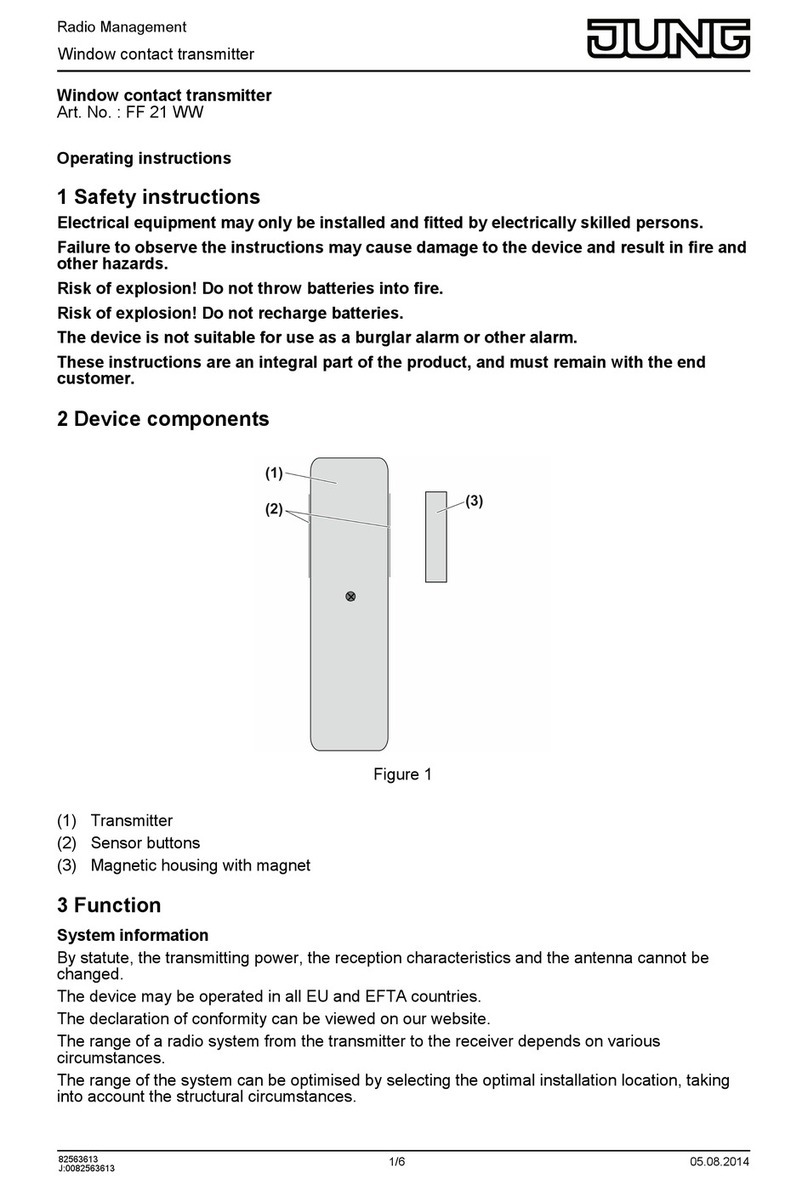
Jung
Jung FF 21 WW User manual
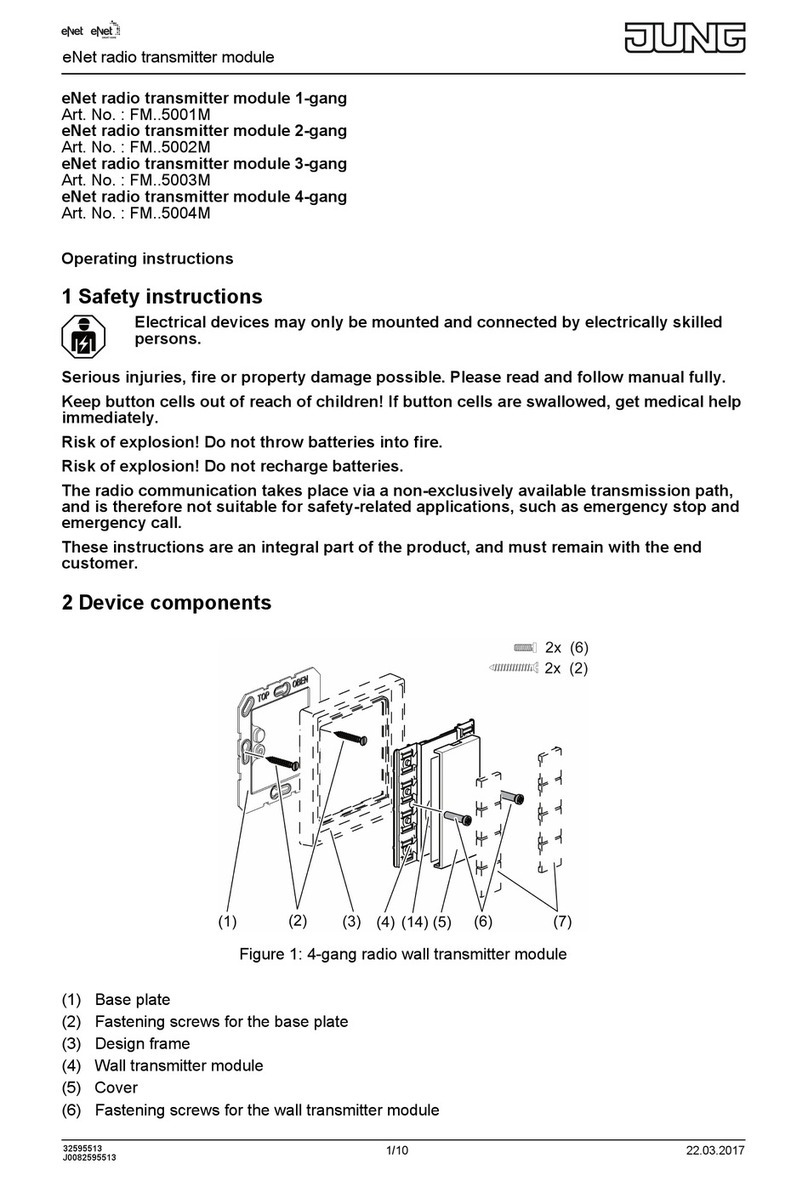
Jung
Jung FMx5001M Series User manual
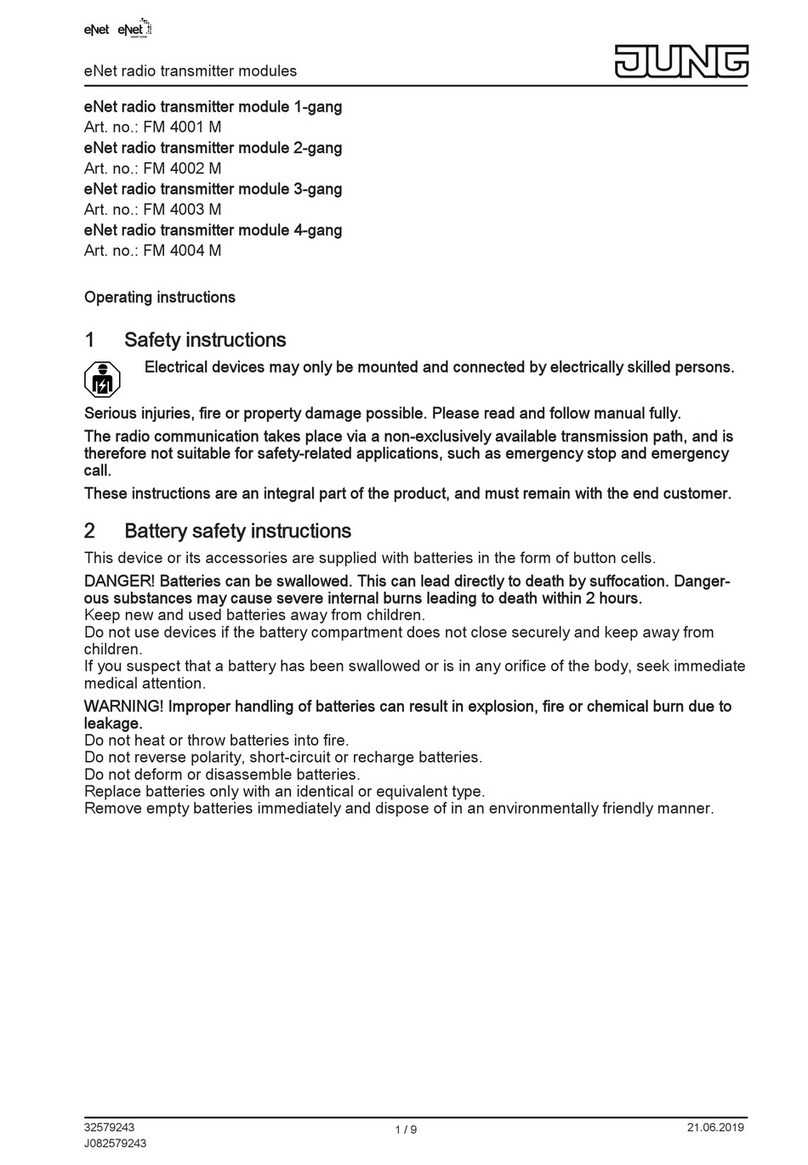
Jung
Jung eNet FM 4001 M User manual
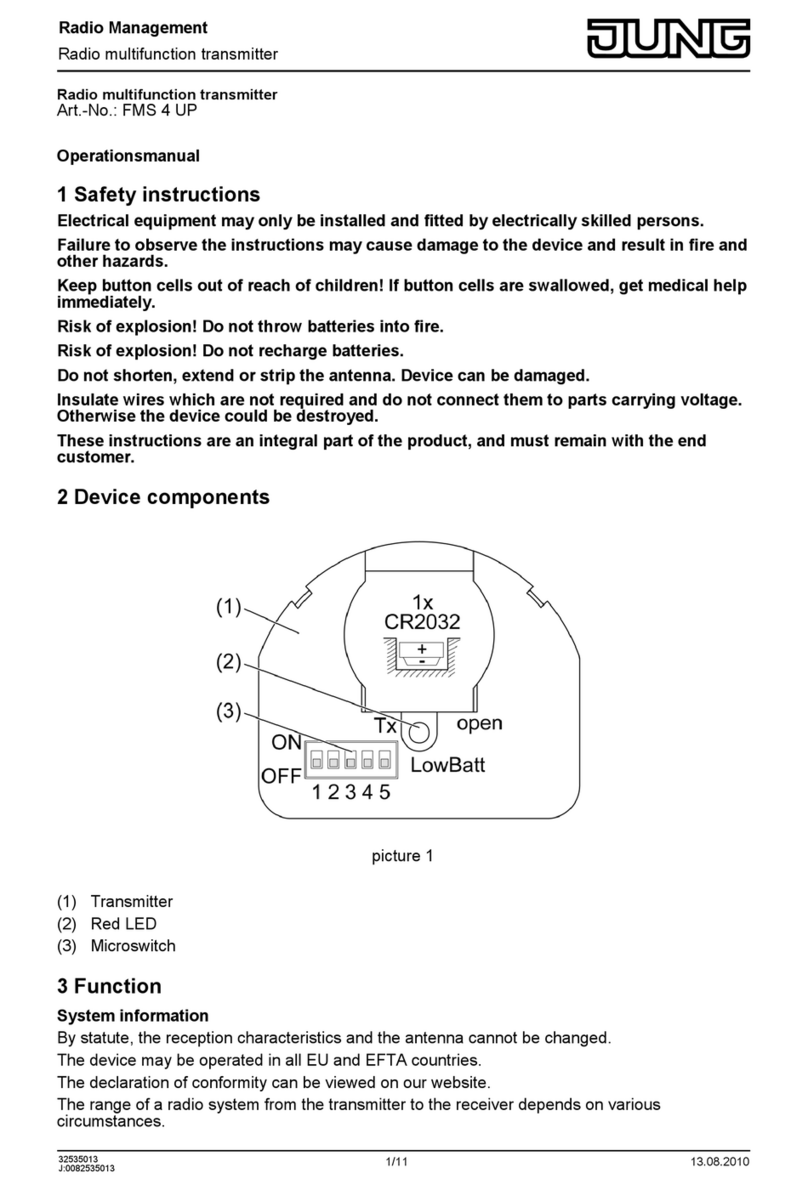
Jung
Jung FMS 4 UP User manual
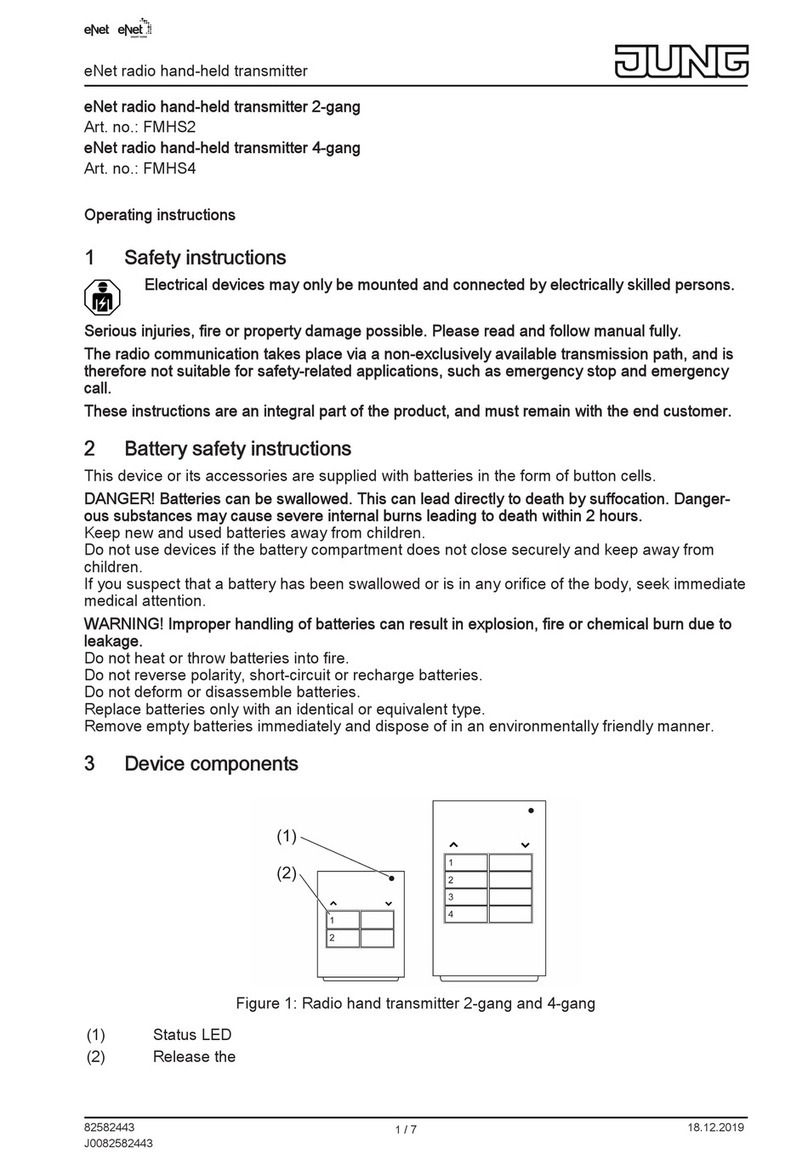
Jung
Jung eNet FMHS2 User manual
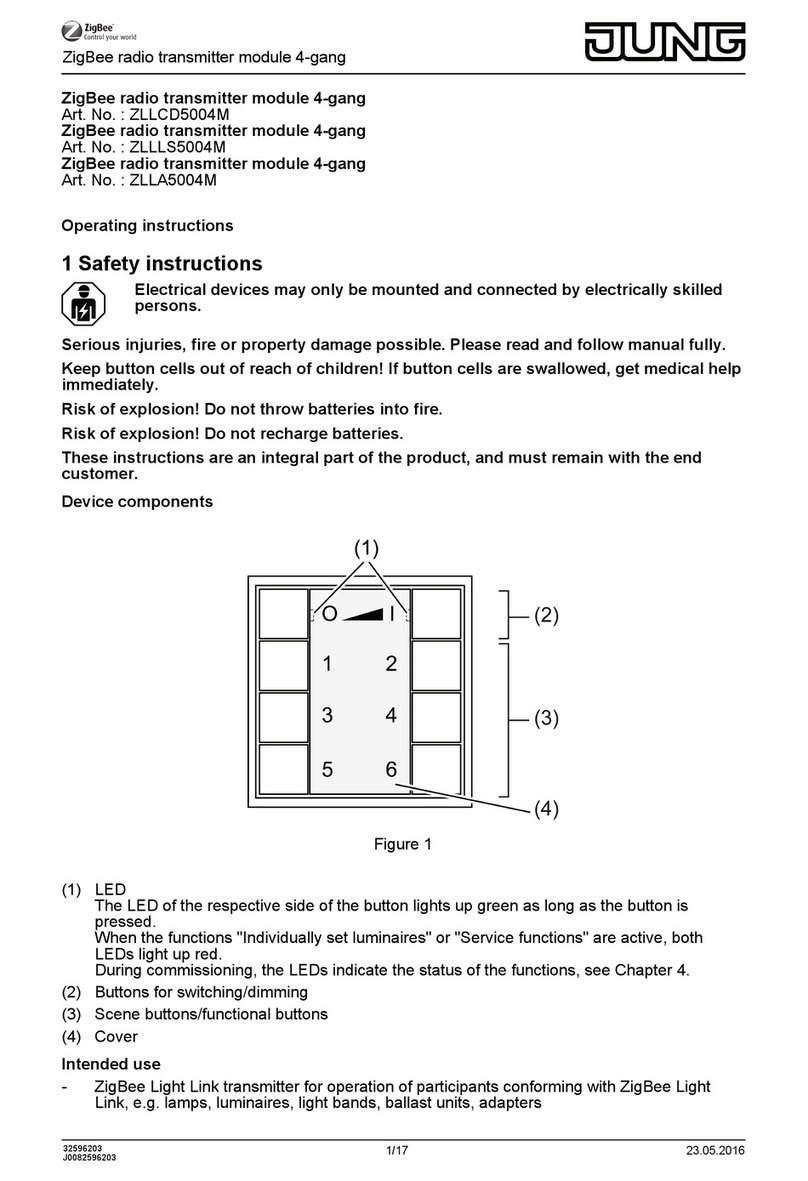
Jung
Jung ZLLCD5004M User manual

Jung
Jung EnOcean ENO A 590 Series User manual
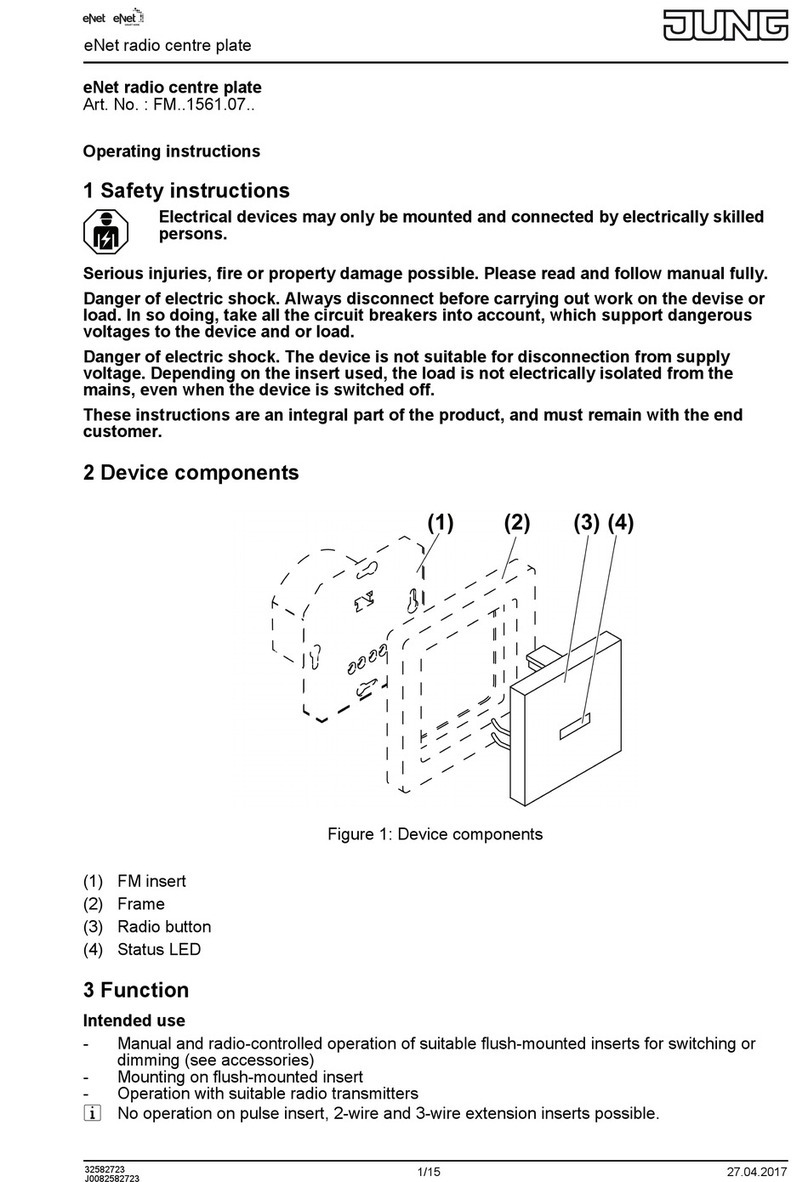
Jung
Jung FM Series User manual
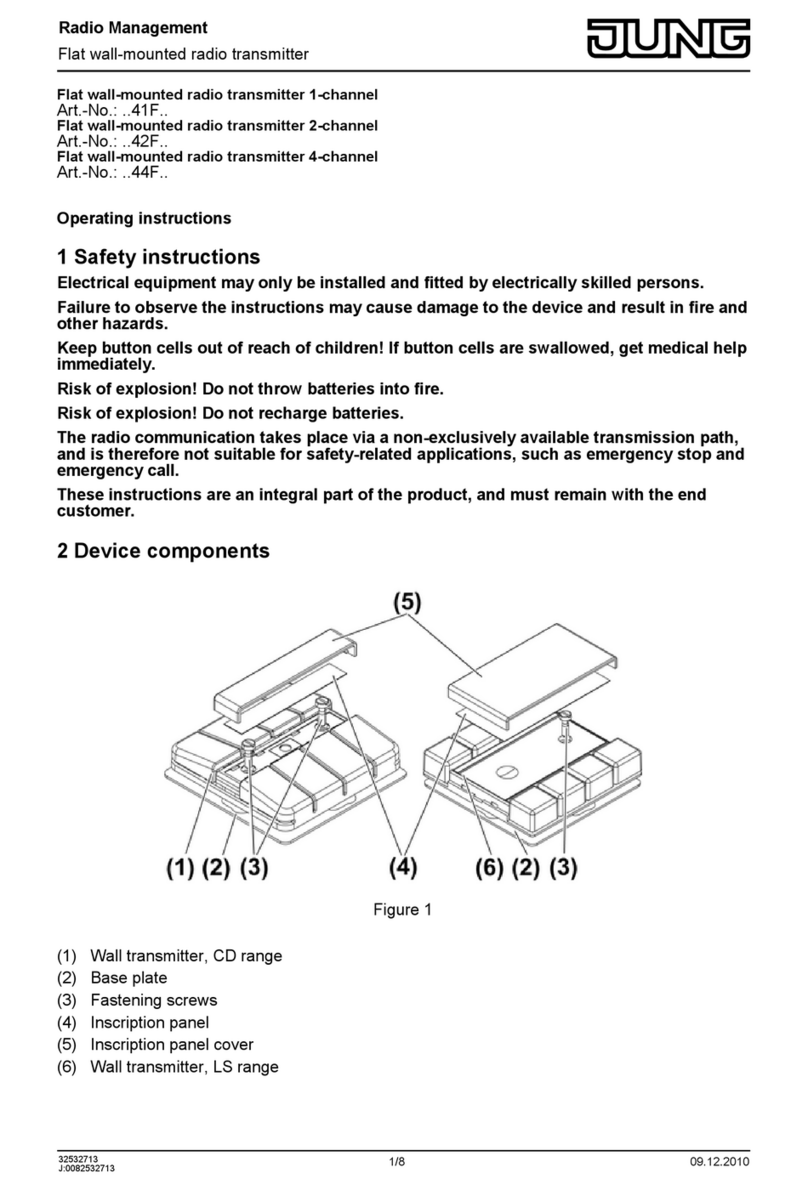
Jung
Jung 41F Series User manual
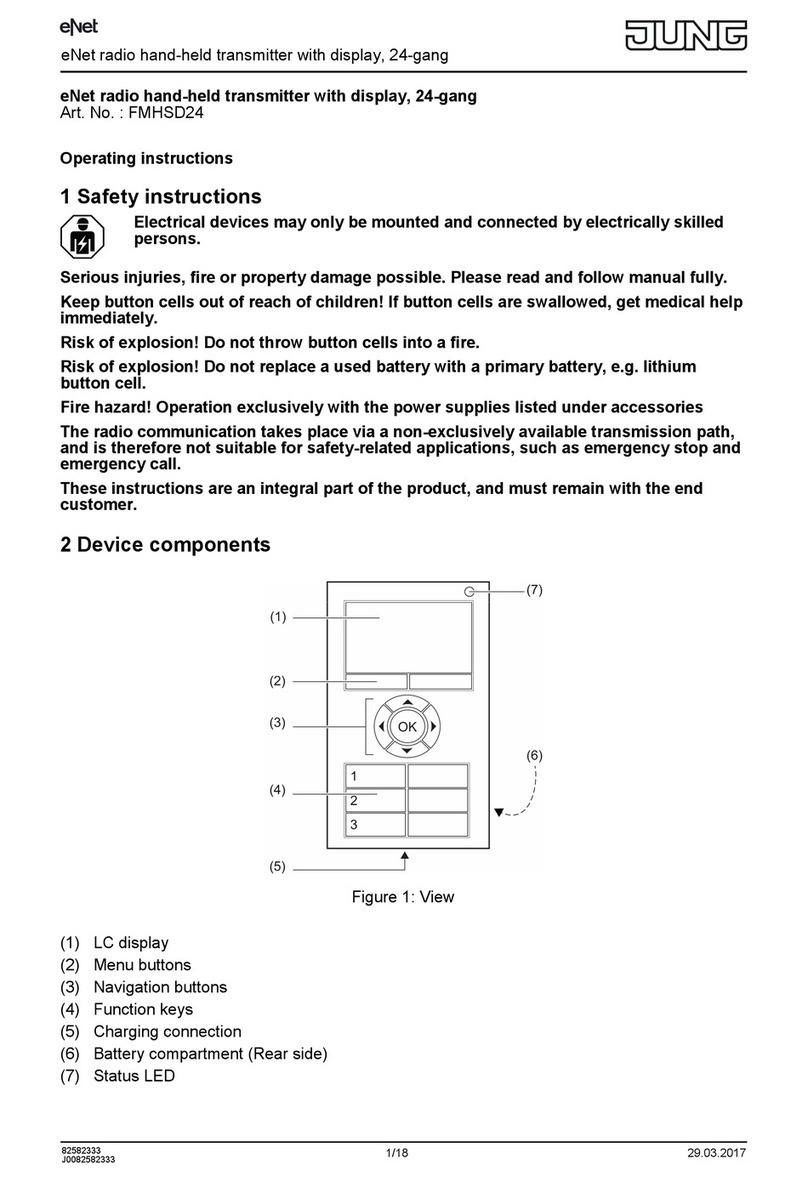
Jung
Jung FMHSD24 User manual
